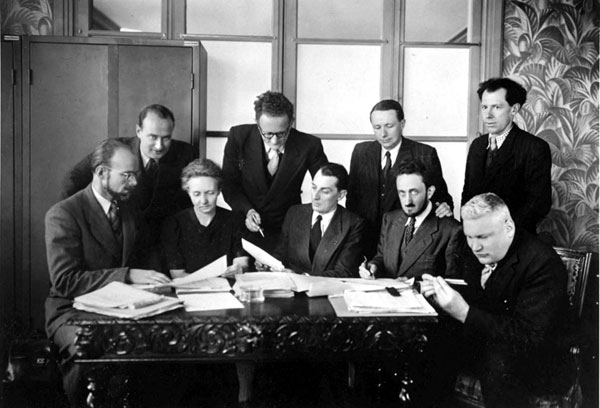French Alternative Energies and Atomic Energy Commission (CEA) Implementing Scality
For HPC storage for tens of petabytes
This is a Press Release edited by StorageNewsletter.com on November 4, 2015 at 4:24 pmScality, Inc. has been selected by the French Alternative Energies and Atomic Energy Commission (CEA) to power its HPC storage needs at the Scientific Computing Complex of the CEA’s Military Applications Division (DAM).
Scientific Committee of the CEA in 1946
Scality and CEA will work together to advance their ongoing R&D projects, as well as CEA’s own HPC contributions, including the ‘Lustre’, ‘RobinHood’ and ‘Ganesha’ software solutions, and to collaborate on an exascale project environment.
CEA selected the Scality RING because it allows hardware freedom; CEA can choose to implement any standard x86 hardware today, as well as in the future, without worrying about data migration or the ability to use mixed hardware. Because the Scality RING scales out linearly and limitlessly, CEA will have endless storage to meet their many large scale HPC needs.
The CEA/DAM site in Île-de-France houses one of the most high-powered computing complexes in Europe, with peak computing power greater than 3 petaflops (the ability to do one quadrillion floating point operations per second [FLOPS]) and a storage capacity of tens of petabytes.
“We’ve invested to work with Scality for the next five years,” said Jacques-Charles Lafoucrière, the head of Scientific Computing Complex department, CEA. “Scality RING was chosen because of its original architecture, high scalability, and great potential. Soon after implementing the RING, we were immediately able to take advantage of the agnostic hardware as well as the Scality interfaces. Looking to the future, we plan on working closely with the Scality team to create an exascale project environment with the goal of making exascale computing a reality.“
As an active member of the Lustre community, CEA focuses on the core technology as well as add-on features like Lustre HSM functionality and an advanced open source project for policy management called RobinHood, with the goal of dealing with the growing amount of data and metadata on its HPC file systems.
The Scality RING will be used as a testbed to develop an object-based interface for allowing Lustre volumes to be tiered with the Scality RING as a second tier. Initial investigations will be performed concurrently to determine if a straightforward mechanism to tier data from Scality to tape for longer term archiving can be implemented. Scality’s flexible interface architecture affords CEA the ability to investigate different solutions, increasing flexibility and lowering time for adaptation.
The CEA has also developed one of the industry’s most sophisticated pNFS (parallel network file system) open source implementations, called Ganesha, a multiusage large cache NFSv4 server. Scality will integrate its current interface architecture with Ganesha, which combined will enable very large scale pNFS installations.
“In keeping with one of the main objectives from CEA’s mission statement – to become the leading technology research organization – we are looking forward to the opportunity to work with CEA to make exascale computing a reality,” said Erwan Menard, COO, Scality. “One of the main tenets of the Scality RING is high performance, and it is by design, to address the mounting needs of the HPC community.“













 Subscribe to our free daily newsletter
Subscribe to our free daily newsletter
